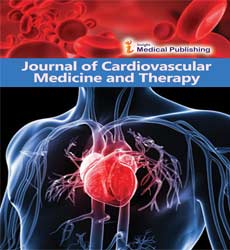Cardiovascular Disease, Drug Therapy and Mortality in Covid-19
Henna Zen*
Department of Cardiovascular Medicine and Therapy, University of Sydney, Australia
- *Corresponding Author:
- Henna Zen
Department of Cardiovascular Medicine and Therapy, University of Sydney, Australia
Tel: 8241707520
E-mail: hennazen1421@gmail.com
Received Date: December 03, 2021; Accepted Date: December 16, 2021; Published Date: December 23, 2021
Citation: Zen H (2021) Cardiovascular Disease, Drug Therapy and Mortality in Covid-19. J Cardiovasc Med Vol:4 No:3
Short Communication
The strains of a changing health-care system are putting a strain on both fundamental science and clinical faculty's ability to devote time and effort to medical education. Multimedia computer instruction, which is applicable at all levels of medical education, produced according to instructional design principles and supported by evidence of success has the ability to compensate for reduced faculty time and thereby improve medical education. The authors report their experiences implementing a comprehensive computer-based four-year bedside cardiology curriculum established by a collaboration of university cardiologists and educational professionals at six medical schools.
The course included the history, physical examination, laboratory data, diagnosis and treatment through 10 interactive, patient-centred, case-based modules. While an optimal implementation method was suggested, each institution chose its own path. The project's main objectives, which ran from July 1996 to June 1997, were to identify and resolve implementation issues, as well as to assess learners and instructors acceptance of the system and their perceptions of its usefulness. Individual modules of the curriculum were used 6,131 times by 1,586 pupils. Over 80% of students said the system was excellent in every way, especially in terms of clarity and educational value when compared to traditional lectures. The authors discuss the aspects of the curriculum that worked, problems that arose (such as scheduling use of the modules in the third year), barriers to change and how to overcome them (such as the type of team needed to gain acceptance for and oversee implementation of this type of curriculum) and the need to formally assess the educational effectiveness of this and similar types of computer-based curricula in subsequent years. The cardiovascular community has taken an interest in social media channels, particularly Twitter, as a means of disseminating cardiovascular research. The use of online attention scores to analyses the performance of scholarly publications on Web-based media and social networks has become popular.
Cardiology publications frequently employ the Altimetry attention score (AAS), a widely used online attention score that provides an objective reflection on how well an item is trending on internet platforms (Digital Science, London, UK). The goal of this study was to see if there was a link between the AAS and the number of citations for cardiovascular research articles. Different online attention measurements, lower impact journals or other disciplines may not be applicable to the findings of this study. Clustering was used to account for factors such as journal impact factor, publishing format and dissemination tactics; nevertheless this conclusion did not account for similar variances between articles published in the same journal, particularly dissemination frequency. The relationship between changes in the AAS and the final citation density could not be determined because the data was collected retroactively.
Conclusion
In conclusion, the results of this study imply that the amount of online attention a cardiovascular research publication receives may be related to the number of citations it receives Identifying journal characteristics and article types associated with authorship misappropriation and determining the prevalence of articles in peer-reviewed medical journals with honorary authors (named authors who do not meet authorship criteria) and ghost authors (individuals who are not named as authors but contribute significantly to the work).
References
- McGaghie WC (1999) Implementation of a four-year multimedia computer curriculum in cardiology at six medical schools. Academic medicine 74:123-129
- Shokr M (2018) Correlation of Altmetric Attention Score With Article Citations in Cardiovascular Research. JACC 72:952–953
- Lisa C (1998) Prevalence of Articles With Honorary Authors and Ghost Authors in Peer-Reviewed Medical Journals. JAMA 280:222-224
- Hochman J (2020) Renin–Angiotensin–Aldosterone System Inhibitors and Risk of Covid-19. R AAS Inhibitors and Risk of Covid-19 382:2441-2448
Open Access Journals
- Aquaculture & Veterinary Science
- Chemistry & Chemical Sciences
- Clinical Sciences
- Engineering
- General Science
- Genetics & Molecular Biology
- Health Care & Nursing
- Immunology & Microbiology
- Materials Science
- Mathematics & Physics
- Medical Sciences
- Neurology & Psychiatry
- Oncology & Cancer Science
- Pharmaceutical Sciences
